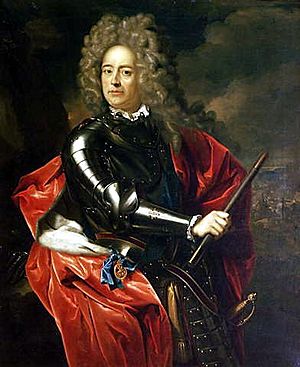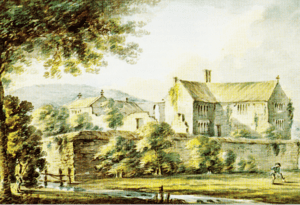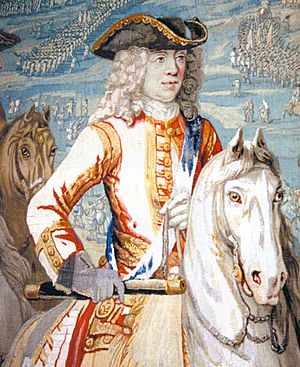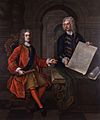John Churchill, 1st Duke of Marlborough facts for kids
Quick facts for kids
The Duke of Marlborough
|
|
|---|---|

Portrait by Adriaen van der Werff
|
|
| First Lord of the Treasury | |
| In office 8 May 1702 – 11 August 1710 |
|
| Monarch | Anne |
| Preceded by | The Earl of Carlisle |
| Succeeded by | The Earl Poulett |
| Personal details | |
| Born | 26 May 1650 Ashe House, Devon, England |
| Died | 16 June 1722 (aged 72) Windsor Lodge, Berkshire, England, Kingdom of Great Britain |
| Spouse | Sarah Jennings |
| Children | 7, including: Henrietta Godolphin, 2nd Duchess of Marlborough Anne Spencer, Countess of Sunderland John Churchill, Marquess of Blandford |
| Parents | Winston Churchill Elizabeth Drake |
| Signature | |
| Military service | |
| Allegiance | |
| Branch/service | English army British army |
| Rank | General |
| Commands | Commander-in-Chief of the Forces Master-General of the Ordnance |
| Battles/wars | Monmouth Rebellion |
| Awards | Knight of the Order of the Garter |
General John Churchill, 1st Duke of Marlborough was a famous English soldier and leader. He served five different kings and queens during his long career. He is known as one of Europe's greatest military commanders.
Contents
Growing Up
John Churchill was born on May 26, 1650. He was the second son of Winston Churchill and Elizabeth Drake. His family lived at Ash House in Devon, England.
His father, Winston, fought for the King during the English Civil War. Because of this, the family had to pay a lot of money in fines. This meant they had to live with John's grandmother for a while.
John had four brothers and sisters who lived to be adults. His older sister was Arabella. His younger brothers were George and Charles.
When King Charles II returned to power in 1660, John's father became a Member of Parliament. He also got a job in London. John went to St Paul's School in London.
In 1665, John's sister Arabella became a special helper to the King's wife. This helped John and his brothers get jobs too. John became a page (a young helper) for James, the Duke of York. In 1667, he joined the army as an ensign in the Foot Guards.
A Famous Military Career
John Churchill quickly became known for his bravery and skill. In the 1670s and 1680s, he rose through the ranks in the army. He also became important in politics.
In 1685, he helped King James II defeat a rebellion. But just three years later, he supported William of Orange instead. William was a Protestant leader from the Netherlands. He became King William III of England.
For his help, John Churchill was made the Earl of Marlborough. He continued to serve with honor in the Nine Years' War. However, he was accused of secretly supporting the old king. He was even put in the Tower of London for a short time.
His true rise to power began in 1702. This was when Queen Anne became queen.
Leading the Army
Marlborough's marriage to Sarah Jennings was very important. Sarah was a close friend of Queen Anne. This friendship helped Marlborough become the Captain-General of the British forces. He was then made a Duke.
He became the leader of the Allied armies in the War of the Spanish Succession. This was a big war that involved many European countries. Marlborough led his troops to several major victories.
His most famous wins include:
- The Battle of Blenheim in 1704
- The Battle of Ramillies in 1706
- The Battle of Oudenarde in 1708
- The Battle of Malplaquet in 1709
These victories made him one of the greatest generals in history.
Challenges and Return
Marlborough's wife, Sarah, had a difficult relationship with Queen Anne. This caused problems for Marlborough too. Sarah was eventually dismissed from court.
Marlborough also faced challenges from different political groups. He was caught between the Tories and the Whigs. Even though he brought glory to Queen Anne's reign, he was forced to leave his job. He went into exile for a while.
He returned to England in 1714 when George I became king. Marlborough regained some of his influence.
Marlborough's Legacy
Marlborough's ambition helped him become one of the richest people in England. His family connections linked him to important European families. His leadership helped Britain become a major world power.
He was excellent at keeping the different allied countries working together. This showed his great diplomatic skills. For ten years during the Spanish Succession war, he held the alliance against France together. He did this through his strong personality.
His victories helped Britain grow from a smaller nation to a powerful one. This led to more wealth for the country in the 1700s.
Marlborough was also a great organizer. He paid close attention to details. This meant his soldiers almost always had enough supplies. His army was ready to fight when it reached its destination. He cared for his soldiers and shared the dangers of battle. This earned him their respect and admiration.
Even his enemies recognized his amazing qualities. His success came from his great strength, willpower, and self-control. His ability to keep the alliance strong against France cannot be overstated.
Later Life and Death
John Churchill suffered a stroke in June 1722. He was living at Windsor Lodge at the time. He passed away shortly after his 72nd birthday. His wife Sarah and two of his daughters were with him.
He was first buried in Westminster Abbey. But his wife Sarah, who died in 1744, wanted him moved. She asked for him to be buried next to her. So, Marlborough was moved to the chapel at Blenheim Palace.
Family Life
Around 1675, John Churchill met Sarah Jennings. She came from a similar background to him. Her family had also lost money during the war.
Sarah and her sister joined the household of James's second wife. John's father wanted him to marry a rich woman. But John married Sarah in the winter of 1677–78.
John and Sarah had five children who lived to be adults:
- Henrietta Churchill, who became the 2nd Duchess of Marlborough
- Lady Anne Churchill
- John Churchill, Marquess of Blandford
- Elizabeth
- Mary
Titles and Honors
John Churchill received many important titles during his life:
- He became Lord Churchill of Eyemouth in 1682.
- He was made Baron Churchill of Sandridge in 1685.
- He became Earl of Marlborough in 1689.
- His most famous title was Duke of Marlborough, which he received in 1702.
- He was also given the title Prince of Mindelheim in 1705.
He was also a Knight of the Order of the Garter. This is a very special honor in England.
Images for kids
-
Sarah Churchill, Duchess of Marlborough; attributed to Godfrey Kneller
-
Marlborough in his thirties, attributed to John Riley. The Star of the Order of the Garter was added after 1707.
-
Princess Anne 1683 by Willem Wissing. When Mary died childless in 1694 (O.S.), Anne, her sister, became heir apparent.
-
Sidney Godolphin, Lord Treasurer, Chief Minister and fellow Tory friend of Marlborough
-
Europe in 1700; Marlborough fought principally in the Low Countries.
-
Marlborough at the Battle of Ramillies, 1706
-
Robert Harley by Jonathan Richardson, c. 1710. Harley became Marlborough's nemesis.
-
Marlborough at the Battle of Oudenaarde, 1708
-
Marlborough and John Armstrong his chief engineer, possibly by Enoch Seeman. Depicted discussing the Siege of Bouchain.
-
John Vanbrugh's Blenheim Palace. Begun in 1705, but plagued by financial troubles, this "pile of stones", as the Duchess resentfully called it, was finally completed in 1733.
-
Blenheim Column of Victory on the grounds of the Blenheim estate, Oxfordshire
See also
 In Spanish: John Churchill, I duque de Marlborough para niños
In Spanish: John Churchill, I duque de Marlborough para niños





























